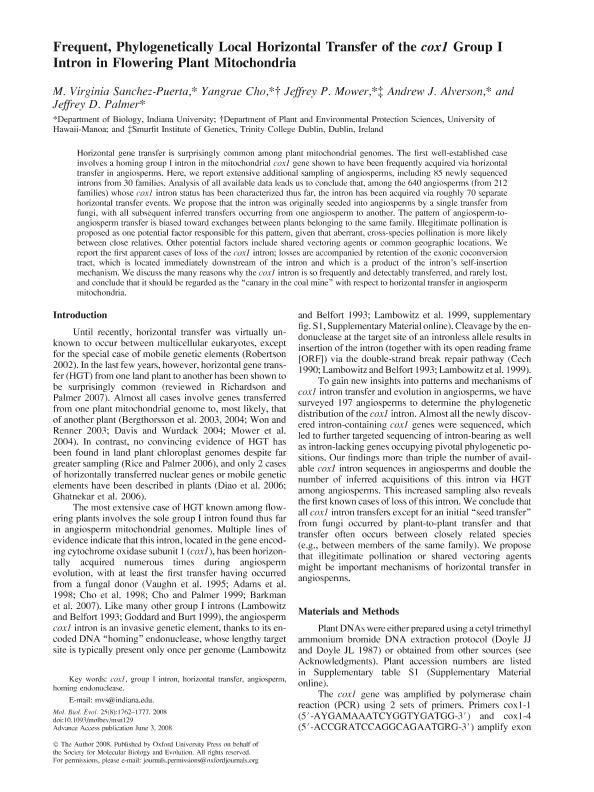Mostrar el registro sencillo del ítem
dc.contributor.author
Sánchez Puerta, María Virginia

dc.contributor.author
Cho, Yangrae
dc.contributor.author
Mower, Jeffrey P.
dc.contributor.author
Alverson, Andrew J.
dc.contributor.author
Palmer, Jeffrey D.
dc.date.available
2022-05-17T10:32:19Z
dc.date.issued
2008-06
dc.identifier.citation
Sánchez Puerta, María Virginia; Cho, Yangrae; Mower, Jeffrey P.; Alverson, Andrew J.; Palmer, Jeffrey D.; Frequent, phylogenetically local horizontal transfer of the cox1 group I intron in flowering plant mitochondria; Oxford University Press; Molecular Biology and Evolution; 25; 8; 6-2008; 1762-1777
dc.identifier.issn
0737-4038
dc.identifier.uri
http://hdl.handle.net/11336/157717
dc.description.abstract
Horizontal gene transfer is surprisingly common among plant mitochondrial genomes. The first well-established case involves a homing group I intron in the mitochondrial cox1 gene shown to have been frequently acquired via horizontal transfer in angiosperms. Here, we report extensive additional sampling of angiosperms, including 85 newly sequenced introns from 30 families. Analysis of all available data leads us to conclude that, among the 640 angiosperms (from 212 families) whose cox1 intron status has been characterized thus far, the intron has been acquired via roughly 70 separate horizontal transfer events. We propose that the intron was originally seeded into angiosperms by a single transfer from fungi, with all subsequent inferred transfers occurring from one angiosperm to another. The pattern of angiosperm-to- angiosperm transfer is biased toward exchanges between plants belonging to the same family. Illegitimate pollination is proposed as one potential factor responsible for this pattern, given that aberrant, cross-species pollination is more likely between close relatives. Other potential factors include shared vectoring agents or common geographic locations. We report the first apparent cases of loss of the cox1 intron; losses are accompanied by retention of the exonic coconversion tract, which is located immediately downstream of the intron and which is a product of the intron’s self-insertion mechanism. We discuss the many reasons why the cox1 intron is so frequently and detectably transferred, and rarely lost, and conclude that it should be regarded as the ‘‘canary in the coal mine’’ with respect to horizontal transfer in angiosperm mitochondria.
dc.format
application/pdf
dc.language.iso
eng
dc.publisher
Oxford University Press

dc.rights
info:eu-repo/semantics/openAccess
dc.rights.uri
https://creativecommons.org/licenses/by-nc-sa/2.5/ar/
dc.subject
COX1
dc.subject
GROUP 1 INTRON
dc.subject
HORIZONTAL TRANSFER
dc.subject
ANGIOSPERM
dc.subject.classification
Biología Celular, Microbiología

dc.subject.classification
Ciencias Biológicas

dc.subject.classification
CIENCIAS NATURALES Y EXACTAS

dc.title
Frequent, phylogenetically local horizontal transfer of the cox1 group I intron in flowering plant mitochondria
dc.type
info:eu-repo/semantics/article
dc.type
info:ar-repo/semantics/artículo
dc.type
info:eu-repo/semantics/publishedVersion
dc.date.updated
2020-05-19T19:04:23Z
dc.journal.volume
25
dc.journal.number
8
dc.journal.pagination
1762-1777
dc.journal.pais
Reino Unido

dc.description.fil
Fil: Sánchez Puerta, María Virginia. Consejo Nacional de Investigaciones Científicas y Técnicas. Centro Científico Tecnológico Conicet - Mendoza. Instituto de Biología Agrícola de Mendoza. Universidad Nacional de Cuyo. Facultad de Ciencias Agrarias. Instituto de Biología Agrícola de Mendoza; Argentina. Indiana University; Estados Unidos
dc.description.fil
Fil: Cho, Yangrae. Indiana University; Estados Unidos
dc.description.fil
Fil: Mower, Jeffrey P.. Indiana University; Estados Unidos
dc.description.fil
Fil: Alverson, Andrew J.. Indiana University; Estados Unidos
dc.description.fil
Fil: Palmer, Jeffrey D.. Indiana University; Estados Unidos
dc.journal.title
Molecular Biology and Evolution

dc.relation.alternativeid
info:eu-repo/semantics/altIdentifier/doi/http://dx.doi.org/10.1093/molbev/msn129
dc.relation.alternativeid
info:eu-repo/semantics/altIdentifier/url/https://academic.oup.com/mbe/article/25/8/1762/1116655
Archivos asociados
